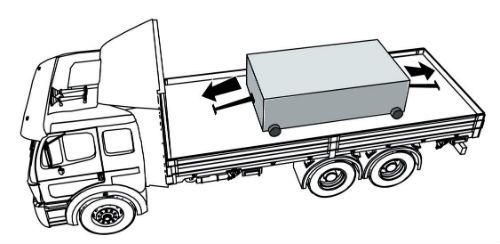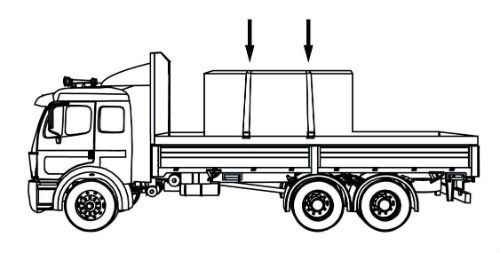CDL Practice Tests: Flatbed Cargo Securement
Choose A Section:
Go!Option #3 for securing metal coils transported with eyes lengthwise includes all of the following except:
- Attaching at least one tiedown over the top of the coil near the front of the coil.
- Attaching at least two tiedowns through the center of the coil.
- Attaching at least one tiedown over the top of the coil near the rear of the coil.
- Using blocking or friction mats to prevent forward movement.
Tiedowns, Single Coil Option #3
Option #3 is the same as Options #1 and #2, except that the two tiedowns that attach through the eye of the coil are replaced with two tiedowns that pass over the front and the rear of the coil.

Attach at least one tiedown over the top of the coil near the front of the coil.
Attach at least one tiedown over the top of the coil near the rear of the coil.
Use blocking or friction mats to prevent forward movement.
A dunnage bag is:
- A waterproof sheet used to cover cargo.
- A transverse load bearing structural component, particularly a part of a log bunk.
- A structure, device, or another substantial article placed against or around an article to prevent horizontal movement of the article.
- An inflatable bag intended to fill otherwise empty space between articles of cargo, or between articles of cargo and the wall of the vehicle.
Dunnage bag:
An inflatable bag intended to fill otherwise empty space between articles of cargo, or between articles of cargo and the wall of the vehicle.
Requirements for securing heavy vehicles, equipment, and machinery apply at what weight?
- More than 4,500 lbs
- More than 10,000 lbs
- Less than 10,000 lbs
- 50% the weight of the trailer
What Does This Section Cover?
The requirements in this section apply to the transportation of heavy vehicles, equipment, and machinery that:
- Operate on wheels or tracks, such as front end loaders, bulldozers, tractors, and power shovels.
- Individually weigh more than 4500 kg (10,000 lb.).
When using tiedowns to secure boulders, all of the following are requirements except:
- Tiedowns should be located in valleys or notches across the top of the boulder.
- Use only chain to secure large boulders.
- Tiedowns must be arranged to prevent sliding across the rock surface.
- Boulders must be loaded as far back towards the rear as possible.
Requirements

Use only chain to secure large boulders.
Tiedowns in direct contact with the boulder:

Should be located in valleys or notches across the top of the boulder
Must be arranged to prevent sliding across the rock surface.
What is bell pipe concrete?
- Concrete used to make bell pipe.
- Pipe whose flanged end is of smaller diameter than its barrel.
- Pipe whose flanged end is of larger diameter than its barrel.
- Pipe used to make concrete bells.
Bell Pipe Concrete:
Pipe whose flanged end is of larger diameter than its barrel.
Load securement for cargo weighing 29,650 lbs must be able to withstand upward force of how many lbs?
- 29,650 lbs
- 30,000 lbs
- 14,825 lbs
- 5,930 lbs
How strong must the vehicle structure and anchor points be?
All elements of the vehicle structure and anchor points must be strong enough to withstand the forces described on page 7.
- Forward force: 0.8 g (80%)
- Rearward force: 0.5.g (50%)
- Sideways force: 0.5 g (50%)
- Upward force: 0.2 g (20%)
The term 'edge protector' refers to:
- A rail along the side of a vehicle that protects the side of the vehicle from impacts.
- A device placed on the exposed edge of an article to distribute tiedown forces over a larger area of cargo than the tiedown itself, to protect the tie-down and/or cargo from damage, and to allow the tiedown to slide freely when being tensioned.
- A vertical barrier placed directly behind the cab of a tractor to protect the cab in the event cargo should shift forward.
- A structure, device, or another substantial article placed against an article to prevent it from tipping that may also prevent it from shifting.
Edge protector:
A device placed on the exposed edge of an article to distribute tiedown forces over a larger area of cargo than the tiedown itself, to protect the tie-down and/or cargo from damage, and to allow the tiedown to slide freely when being tensioned.
Which of the following is not a reason why loads should be secured?
- Prevent loss of load
- Make it look pretty
- Prevent damage to the cargo
- Avoid fines and citations
Why secure your load? To prevent:
- Loss of life
- Loss of load
- Damage to the cargo
- Damage to the vehicle
- Issuance of citations/fines to driver/carrier
- The vehicle being placed Out-of-Service.
- A crash
If loading and securing paper rolls on a second layer:
- Be sure the bottom layer extends to the front of the vehicle.
- Lay the second layer horizontally.
- Stack the second layer at the back.
- Make sure heavier rolls are on top.
Stacked Loads
- Load paper rolls on a second layer only if the bottom layer extends to the front of the vehicle.
-
Prevent forward, rearward, or side-to-side movement:
- Either by the same means required for the bottom layer
- Or by the use of a blocking roll from a lower layer.
- A roll in the rearmost row of any layer must not be raised using dunnage.
Which of the following is not a method of securing side-by-side cargo?
- Fill the empty space between with other cargo.
- Make sure it is leaning forward.
- Use some kind of blocking to prevent shifting.
- Place them in direct contact with each other.
For articles of cargo placed beside each other and secured by side-to-side tiedowns:

Either place them in direct contact with each other,
Or prevent them from shifting towards each other in transit by using blocking or filling the space with other cargo.
About The Flatbed Cargo Securement CDL Manual
Studying the flatbed cargo securement CDL manual is not a requirement for getting your CDL permit or license. It is required knowledge for flatbed drivers.
Some questions you should be able to answer for flatbed cargo securement:
- What is the minimum Working Load Limit of a tiedown used to secure logs?
- What is the minimum weight of a shipment of paper rolls that would require specific securement requirements?
- When securing concrete pipe over 45 inches loaded crosswise, which direction must the tiedowns on the front half of the load run?
- What is a cab shield?
- When securing concrete pipe over 45 inches loaded crosswise, which direction must the tiedowns on the rear half of the load run?
- What is a dunnage bag?
- Who is responsible for inspecting securing devices and cargo within the first 50 miles?
- How many tiedowns are required on a stack of shortwood loaded crosswise?
- What is the minimum working load limit of each tiedown used to secure crushed or flattened vehicles?
- Define 'bolster'
- What is a hook-lift container?
- When a tiedown is attached directly to the cargo, what is the ideal angle where it attached to the vehicle?
What is a securing device?
Any device specifically manufactured to attach or secure cargo to a vehicle or trailer:
- Synthetic Webbing
- Chain
- Wire rope
- Manila rope
- Synthetic rope
- Steel strapping
- Clamps and latches
- Blocking
- Front-end structure
- Grab hooks
- Binders
- Shackles
- Winches
- Stake pockets
- D-rings
- Webbing ratchet
- Bracing
- Friction mat
What is a tiedown?
A combination of securing devices that forms an assembly that:
- Attaches cargo to, or restrains cargo on a vehicle.
- Is attached to anchor point(s).

Some tiedowns are attached to the cargo and provide direct resistance to restrain the cargo from movement.

Some tie-downs pass over or through the cargo. They create a downward force that increases the effect of friction between the cargo and the deck. This friction restrains the cargo.
 Related Cargo Securement Terms That Every Driver Should Know:
Related Cargo Securement Terms That Every Driver Should Know:
-
Tiedown:
A combination of securing devices which form an assembly that attaches cargo to, or restrains cargo on, a vehicle or trailer, and is attached to anchor point(s).
-
Contained:
Cargo is contained if it fills a sided vehicle, and every article is in contact with or sufficiently close to a wall or other articles so that it cannot shift or tip if those other articles are also unable to shift or tip.
-
Blocking:
A structure, device, or another substantial article placed against or around an article to prevent horizontal movement of the article.
How should tiedowns be attached?
Tiedowns can be used in two ways:
-
Attached to the cargo:
- Tiedowns attached to the vehicle and attached to the cargo.
- Tiedowns attached to the vehicle, pass through or aroundan article of cargo, and then are attached to the vehicle again.
-
Pass over the cargo:
- Tiedowns attached to the vehicle, passed over the cargo, and then attached to the vehicle again.
Tiedown placement:

Place the tiedown as close as possible to the spacer.
Position the tiedowns as symetrically as possible over the length of the article.

Position the tiedowns to preserve the integrity of the article.







 TT On Facebook
TT On Facebook